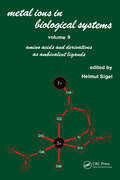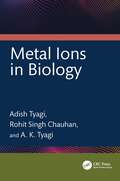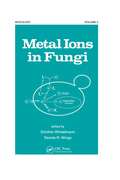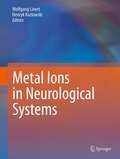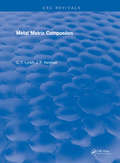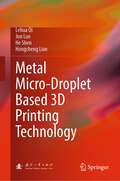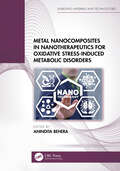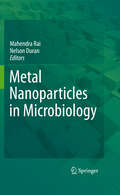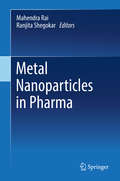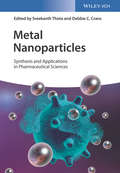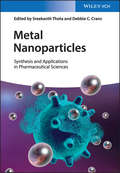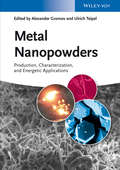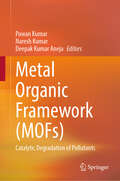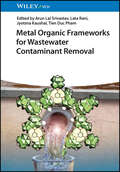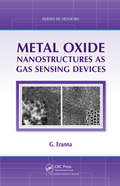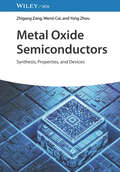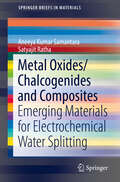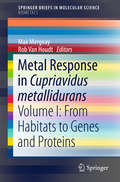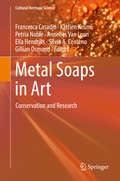- Table View
- List View
Metal Ions in Biological Systems: Volume 9: Amino Acids and Derivatives as Ambivalent Ligands (Metal Ions in Biological Systems)
by Helmut SigelThis book focuses on the connection between the chemistry of metal ions and their role for life, and covers complexes with a number of amino acids with chelatable side chain donor atoms. It discusses metal ion-protein interactions and the ligating ambivalency of nucleotides.
Metal Ions in Biology
by A. K. Tyagi Adish Tyagi Rohit Singh ChauhanThis book discusses the inherent need for and significance of metal ions in metabolic reactions. It details their essential elements and mechanistic prospects in regulating biological reactions, as well as covers the broad domain of elements, including main group as well as transition elements, in a comparative and comprehensive manner. Contemporary and advanced topics, such as nuclear medicine and biomineralization, are also covered.Features: Highlights the different behaviors of Fe/Cu proteins and the structural changes during their biological functioning. Discusses the mechanistic prospects of various enzymes and proteins, e.g., Cu‑Zn SOD, zinc finger, and ionophores. Explores the chemical and biological prospects of trace and ultra‑trace elements. Includes biomimetic models of iron and copper. Reviews the criteria for nature selecting metal ions, why only certain elements are essential, and the differences between biologically induced and biologically controlled biomineralization. This book is aimed at graduate students and researchers in chemical engineering, materials science, chemistry, and biological sciences.
Metal Ions in Fungi
by Günther WinkelmannPresents the latest advances in the study of the intracellular fate and transport of metal ions in fungi, emphasizing the mechanisms that regulate cellular concentration. The book explains the expanding relationship between molecular genetics and inorganic biochemistry.
Metal Ions in Neurological Systems
by Henryk Kozlowski Wolfgang LinertMetal ions in the brain are a necessity as well as a poison. The presence of metal ions in the active sites of biological catalysts or metalloproteins and in the biological functioning of nucleic acids is very well documented and they are required for brain activity. On the other hand, metals are very effective in generating oxidative stress. This effect does not only play a role in immunology but also is the root of practically all neurodegenerative disorders by inducing disease via the death of neurons. Managing metal ions in the brain could therefore be an important strategy in the search for therapeutic agents used in the treatment of neurodegenerative diseases. This new title gives an overview to key topics in the area of metal ions in the brain. It focuses on the role of metal ions in neurological systems by describing their advantageous functions as well as their poisonous features. It is therefore of interest for scientists in biochemistry and biophysics, physiology, toxicology as well as for physicians focused on this topic.
Metal Matrix Composites
by C.T. LynchThe concept of reinforcing a material by the use of a fiber is not a new one. The Egyptian brick layer employed the same principle more than three thousand years ago when straw was incorporated into the bricks. More recent examples of fiber reinforced composites are steel-reinforced concrete, nylon and rayon cord reinforced tires, and fiberglass reinforced plastics. In the last several years considerable progress has been made on new composite structures particularly utilizing boron (on tungsten substrate) fibers in various matrices. Many of these advances have been reviewed recently by P. M. Sinclair1 and by Alexander, Shaver, and Withers.2 An excellent earlier survey is available by Rauch Sutton, and McCreight.3 Boron-reinforced epoxy composites are being fabricated and tested as jet engine components, fuselage components, and even as a complete aircraft wing because of the tremendous gain in experimentally demonstrated properties such as modulus, strength, and fatigue resistance, particularly on a weight normalized (e.g., strength/density) basis. Other than glass/epoxy and boron/ epoxy composites and perhaps boron/aluminum, the systems now under study are in the early stages of research and development. These include other boron/metal composites, graphite/polymer, graphite/metal, graphite/graphite, alumina/metal, and aligned eutectic (directionally, solidified) combinations. As Sinclair points out, designers are wary about filamentary composites becausethere is little background information and scant experience.
Metal Micro-Droplet Based 3D Printing Technology
by Jun Luo Lehua Qi He Shen Hongcheng LianThis book introduces a unique 3D printing method that prints metal parts by ejecting metal micro-droplets: a low-cost, contactless, and environmentally friendly 3D printing technology. This book follows a deductive approach to describe the fundamentals of metal droplet-based 3D printing and reveal the relationships and unique features among multiple specific techniques used in droplet-based 3D printing. It starts with a general description of the principles and techniques involved in this technology and then focuses on the details of several specific metal droplet-ejection methods. Next, it puts forward various specific 3D printing techniques and illustrates their applications. This book is a valuable reference for scholars and researchers who work on metal 3D printing and other related areas. It is also used as a textbook for college graduate courses in mechanical manufacturing and material processing.
Metal Nanocomposites in Nanotherapeutics for Oxidative Stress-Induced Metabolic Disorders (Emerging Materials and Technologies)
by Anindita BeheraThis book highlights the role and mechanism of different metal nanocomposites toward oxidative stress-induced metabolic disorders including metabolic pathways affected by oxidative stress and related pathophysiology. The book includes an illustrative discussion about the methods of synthesis, characterization, and biomedical applications of metal nanocomposites. It focuses on the therapeutic approaches for metabolic disorders due to oxidative stress by nano delivery systems. Moreover, the book includes chapters on nanotherapeutic approaches toward different diseases, including diabetes mellitus, obesity, cardiovascular disorders, cancers, and neurodegenerative diseases such as Alzheimer's disease and Parkinson's disease. This book is aimed at researchers and graduate students in nanocomposites, nano delivery systems, and bioengineering. Features Discusses nanocomposites in the field of therapy for diabetes, obesity, cardiovascular disorders, neurodegenerative diseases, and cancers Details the pathophysiology of oxidative stress-induced metabolic disorder Explains mechanisms of the antioxidant potential of metal nanocomposites Discusses pathways to elucidate the therapeutic activity Reviews specific and precise applications of metal nanocomposites against lifestyle-induced disorders
Metal Nanoparticles in Microbiology
by Mahendra Rai Nelson DuranFollowing an introduction to biogenic metal nanoparticles, this book presents how they can be biosynthesized using bacteria, fungi and yeast, as well as their potential applications in biomedicine. It is shown that the synthesis of nanoparticles using microbes is eco-friendly and results in reproducible metal nanoparticles of well-defined sizes, shapes and structures. This biotechnological approach based on the process of biomineralization exploits the effectiveness and flexibility of biological systems. Chapters include practical protocols for microbial synthesis of nanoparticles and microbial screening methods for isolating a specific nanoparticle producer as well as reviews on process optimization, industrial scale production, biomolecule-nanoparticle interactions, magnetosomes, silver nanoparticles and their numerous applications in medicine, and the application of gold nanoparticles in developing sensitive biosensors.
Metal Nanoparticles in Pharma
by Mahendra Rai Ranjita ShegokarCompletely dedicated to the biomedical applications of metal nanoparticles, this book covers the different toxicity problems found in healthcare situations and also provides comprehensive info on the use of metal nanoparticles in treating various diseases. Metal Nanoparticles in Pharma is the first edited volume to set up the discussion for a clinical setting and to target a pharmaceutical audience of academic and industry-based researchers.
Metal Nanoparticles in Plant Cell, Tissue and Organ Culture
by Duong Tan Nhut Hoang Thanh TungThis edited book presents recent developments in the field of plant biotechnology involving highly efficient micropropagation for the commercial exploitation of nanomaterials (such as silver, cobalt, copper, zinc, magnesium, silicon, iron, nickel, manganese, and selenium nanoparticles, etc.). The book covers the concept, preparation, and synthesis of metallic and non-metallic nanoparticles, as well as their application in plant cell, tissue, and organ culture. Metal nanoparticles have gained significant attention in various fields, including plant cell, tissue, and organ culture. Their unique physical, chemical, and biological properties make them attractive candidates for applications in plant science. Nanomaterials are applied as plant growth regulators to improve plantlet quality by enhancing the quality of in vitro shoots, their growth, and development at both in vitro and ex vitro stages. Since then, the application of nanomaterials in micropropagation has paved the way for replacing previous culture mediums with new nanoparticle mediums, bringing better efficiency and simplicity to plant propagation operations. The book discusses mechanisms, explant surface disinfection, media sterilization, abnormal phenomena, morphogenesis, physiological-biochemical processes, and the accumulation of economically valuable crop compounds in culture mediums supplemented or replaced by metal ions with metal nanoparticles. This book will interest teachers, researchers, scientists, capacity builders, and policymakers. Additionally, it serves as additional reading for undergraduate and graduate students in agriculture, forestry, ecology, soil science, and environmental science.
Metal Nanoparticles: Synthesis and Applications in Pharmaceutical Sciences
by Sreekanth Thota Debbie C. CransA much-needed summary of the importance, synthesis and applications of metal nanoparticles in pharmaceutical sciences, with a focus on gold, silver, copper and platinum nanoparticles. After a brief introduction to the history of metal complexes in medicine and fundamentals of nanotechnology, the chapters continue to describe different methods for preparation of metal nanoparticles. This section is followed by representative presentations of current biomedical applications, such as drug delivery, chemotherapy, and diagnostic imaging. Aimed at stimulating further research in this field, the book serves as an reference guide for academics and professionals working in the field of chemistry and nanotechnology.
Metal Nanoparticles: Synthesis and Applications in Pharmaceutical Sciences
by Sreekanth Thota Debbie C. CransA much-needed summary of the importance, synthesis and applications of metal nanoparticles in pharmaceutical sciences, with a focus on gold, silver, copper and platinum nanoparticles. After a brief introduction to the history of metal complexes in medicine and fundamentals of nanotechnology, the chapters continue to describe different methods for preparation of metal nanoparticles. This section is followed by representative presentations of current biomedical applications, such as drug delivery, chemotherapy, and diagnostic imaging. Aimed at stimulating further research in this field, the book serves as an reference guide for academics and professionals working in the field of chemistry and nanotechnology.
Metal Nanopowders
by Alexander A. Gromov Ulrich TeipelWritten with both postgraduate students and researchers in academia and industry in mind, this reference covers the chemistry behind metal nanopowders, including production, characterization, oxidation and combustion. The contributions from renowned international scientists working in the field detail applications in technologies, scale-up processes and safety aspects surrounding their handling and storage.
Metal Organic Framework (MOFs): Catalytic Degradation of Pollutants
by Pawan Kumar Naresh Kumar Deepak Kumar AnejaThis book presents the fundamental chemistry, synthesis, and classification of Metal Organic Framework (MOFs) for/in catalysis applications. As an introduction, the role of theoretical catalytic degradation studies on MOFs is also covered. The book includes all types of pollutants, i.e., pesticides, plastics, Polycyclic Aromatic Hydrocarbon compounds (PAHs), nitroaromatic compounds, and emerging pollutants degradation studies using MOFs. Finally, the book discusses the challenges and future prospective for catalytic degradation using MOFs. In the last decades, significant attention has been drawn on catalysis applications of Metal Organic Framework (MOFs). It is due to the structural characteristics, i.e., coordination vacancies available in the metal nodes, organocatalytic site of organic linkers, and ligand to metal charge transfer features, etc., of MOFs. Furthermore, some excellent features including presence of pendent groups, functionalization/bio conjugation possibility, optoelectronic properties as hosts, and additional catalytic sites possibility via post-synthetic modification of MOFs have made them potential materials for real-world application.
Metal Organic Frameworks for Wastewater Contaminant Removal
by Arun Lal Srivastav Lata Rani Jyotsna Kaushal Tien Duc PhamMetal Organic Frameworks for Wastewater Contaminant Removal Discover a groundbreaking new wastewater decontamination technology The removal of wastewater contaminants is a key aspect of the water cycle, allowing water to be fed safely back into circulation within a given ecosystem. Metal-Organic Frameworks (MOFs) are a new class of porous materials which can reversibly bind and sequester both metal ions and potentially harmful organic substances, giving them a potentially crucial role in the targeted removal of wastewater contaminants. They may also enable significant cost and energy savings over now-conventional ion exchangers in water treatment plants. Metal Organic Frameworks for Wastewater Contaminant Removal provides an accessible, practical guide to the development, evaluation, and potential applications of MOFs in maintaining the water cycle. It begins with an overview of the major metallic and non-metallic contaminants found in wastewater and their interactions with major MOF-based materials, before moving to the challenges and opportunities provided by MOFs in the pursuit of a sustainable, energy-efficient water cycle. The result is a groundbreaking resource in the ever-expanding global fight to keep water clean and safe. Metal Organic Frameworks for Wastewater Contaminant Removal readers will also find: MOF technology and its water treatment applications discussed in depth for the first time in a major publication Comparison with existing decontamination technologies and environmental risk assessment Applications for environmental as well as industrial toxicants based on recent research and on case studies Metal Organic Frameworks for Wastewater Contaminant Removal is indispensable for water chemists, chemical engineers, environmental chemists, and for any researchers or industry professionals working with water decontamination technologies.
Metal Oxide Nanomaterials for Chemical Sensors
by Sanjay Mathur Michael A. Carpenter Andrei KolmakovThis book presents a state-of-the-art summary and critical analysis of work recently performed in leading research laboratories around the world on the implementation of metal oxide nanomaterial research methodologies for the discovery and optimization of new sensor materials and sensing systems. The book provides a detailed description and analysis of (i) metal oxide nanomaterial sensing principles, (ii) advances in metal oxide nanomaterial synthesis/deposition methods, including colloidal, emulsification, and vapor processing techniques, (iii) analysis of techniques utilized for the development of low temperature metal oxide nanomaterial sensors, thus enabling a broader impact into sensor applications, (iv) advances, challenges and insights gained from the in situ/ex situ analysis of reaction mechanisms, and (v) technical development and integration challenges in the fabrication of sensing arrays and devices.
Metal Oxide Nanostructures as Gas Sensing Devices (ISSN)
by G. ErannaMetal Oxide Nanostructures as Gas Sensing Devices explores the development of an integrated micro gas sensor that is based on advanced metal oxide nanostructures and is compatible with modern semiconductor fabrication technology. This sensor can then be used to create a compact, low-power, handheld device for analyzing air ambience.The book first c
Metal Oxide Semiconductors: Synthesis, Properties, and Devices
by Yong Zhou Zhigang Zang Wensi CaiMetal Oxide Semiconductors Up-to-date resource highlighting highlights emerging applications of metal oxide semiconductors in various areas and current challenges and directions in commercialization Metal Oxide Semiconductors provides a current understanding of oxide semiconductors, covering fundamentals, synthesizing methods, and applications in diodes, thin-film transistors, gas sensors, solar cells, and more. The text presents state-of-the-art information along with fundamental prerequisites for understanding and discusses the current challenges in pursuing commercialization and future directions of this field. Despite rapid advancements in the materials science and device physics of oxide semiconductors over the past decade, the understanding of science and technology in this field remains incomplete due to its relatively short research history; this book aims to bridge the gap between the rapidly advancing research progress in this field and the demand for relevant materials and devices by researchers, engineers, and students. Written by three highly qualified authors, Metal Oxide Semiconductors discusses sample topics such as: Fabrication techniques and principles, covering vacuum-based methods, including sputtering, atomic layer deposition and evaporation, and solution-based methods Fundamentals, progresses, and potentials of p–n heterojunction diodes, Schottky diodes, metal-insulator-semiconductor diodes, and self-switching diodes Applications in thin-film transistors, detailing the current progresses and challenges towards commercialization for n-type TFTs, p-type TFTs, and circuits Detailed discussions on the working mechanisms and representative devices of oxide-based gas sensors, pressure sensors, and PH sensors Applications in optoelectronics, both in solar cells and ultraviolet photodetectors, covering their parameters, materials, and performance Memory applications, including resistive random-access memory, transistor-structured memory devices, transistor-structured artificial synapse, and optical memory transistors A comprehensive monograph covering all aspects of oxide semiconductors, Metal Oxide Semiconductors is an essential resource for materials scientists, electronics engineers, semiconductor physicists, and professionals in the semiconductor and sensor industries who wish to understand all modern developments that have been made in the field.
Metal Oxides/Chalcogenides and Composites: Emerging Materials for Electrochemical Water Splitting (SpringerBriefs in Materials)
by Satyajit Ratha Aneeya Kumar SamantaraThis book covers the recent development of metal oxides, hydroxides and their carbon composites for electrochemical oxidation of water in the production of hydrogen and oxygen as fuels. It includes a detailed discussion on synthesis methodologies for the metal oxides/hydroxides, structural/morphological characterizations, and the key parameters (Tafel plot, Turnover frequency, Faradic efficiency, overpotential, long cycle life etc.) needed to evaluate the electrocatalytic activity of the materials. Additionally, the mechanism behind the electro oxidation process is presented. Readers will find a comprehensive source on the close correlation between metal oxides, hydroxides, composites, and their properties and importance in the generation of hydrogen and oxygen from water.The depletion of fossil fuels from the earth’s crust, and related environmental issues such as climate change, demand that we search for alternative energy resources to achieve some form of sustainable future. In this regard, much scientific research has been devoted to technologies such as solar cells, wind turbines, fuel cells etc. Among them fuel cells attract much attention because of their versatility and efficiency. In fuel cells, different fuels such as hydrogen, CO2, alcohols, acids, methane, oxygen/air, etc. are used as the fuel, and catalysts are employed to produce a chemical reaction for generating electricity. Hence, it is very important to produce these fuels in an efficient, eco-friendly, and cost effective manner. The electrochemical splitting of water is an environmentally friendly process to produce hydrogen (the greener fuel used in fuel cells), but the efficiencies of these hydrogen evolution reactions (cathodic half reaction) are strongly dependent on the anodic half reaction (oxygen evolution reaction), i.e., the better the anodic half, the better will be the cathodic reaction. Further, this oxygen evolution reaction depends on the types of active electrocatalysts used. Though many more synthetic approaches have been explored and different electrocatalysts developed, oxide and hydroxide-based nanomaterials and composites (with graphene, carbon nanotubes etc.) show better performance. This may be due to the availability of more catalytic surface area and electro active centers to carry out the catalysis process.
Metal Oxides: Chemistry and Applications
by J. L. G. FierroThe chemistry of metals has traditionally been more understood than that of its oxides. As catalytic applications continue to grow in a variety of disciplines, Metal Oxides: Chemistry and Applications offers a timely account of transition-metal oxides (TMO), one of the most important classes of metal oxides, in the context of catalysis. The
Metal Phosphates and Phosphonates: Fundamental to Advanced Emerging Applications (Engineering Materials)
by Ram K. GuptaThis book provides fundamental electrochemical behavior and understanding of devices based on Metal Phosphates and Phosphonates. The basic concepts, properties and emerging applications of these materials as batteries, supercapacitors, fuel cells, sensors, biomedical and environmental are covered. Apart from conventional techniques, this book explores new aspects of synthesizing Metal Phosphates and Phosphonates.
Metal Recovery from Electronic Waste: Biological Versus Chemical Leaching For Recovery Of Copper And Gold (IHE Delft PhD Thesis Series)
by Arda IşildarWaste electrical and electronic equipment (WEEE) generation is a global problem. Despite the growing awareness and deterring legislation, most of the WEEE is disposed improperly, i.e. landfilled or otherwise shipped overseas, and treated in sub-standard conditions. Informal recycling of WEEE has catastrophic effects on humans and the environment. WEEE contains considerable quantities of valuable metals such as base metals, precious metals and rare earth elements (REE). Metal recovery from WEEE is conventionally carried out by pyrometallurgical and hydrometallurgical methods. <P><P>In this PhD research, novel metal recovery technologies from WEEE are investigated. Using acidophilic and cyanide-generating bacteria, copper and gold were removed from crushed electronic waste with removal efficiencies of 98.4 and 44.0%, respectively. The leached metals in solution were recovered using sulfidic precipitation and electrowinning separation techniques. Finally, a techno-economic assessment of the technology was studied. This research addresses the knowledge gap on two metal extraction approaches, namely chemical and biological, from a secondary source of metals. The essential parameters of the selective metal recovery processes, scale-up potential, techno-economic and sustainability assessment have been studied.
Metal Response in Cupriavidus metallidurans
by Max Mergeay Guy Vandenbussche Rob HoudtThis book is the second volume of a two-volume set summarizing 40 years of key research findings directly related to metal-resistant Cupriavidus/Ralstonia (Betaproteobacteria). In this second volume, the structural and catalytic data from bacterial primary and secondary transporters (P-ATPases, tripartite chemiosmotic cation/proton efflux systems, cation diffusion facilitators, Major Facilitator Superfamily and some minor categories) are outlined and detailed for the corresponding C. metallidurans proteins. The available three-dimensional structures are reviewed in detail, including RND and membrane fusion proteins (from tripartite chemiosmotic cation/proton efflux systems), sigma and anti-sigma regulatory proteins of the cnr efflux system (resistance to cobalt and nickel) and various periplasmic proteins mainly involved in the response to copper and mercury. In addition, the first volume sketches the historical and geographical context of these bacteria, which are mostly found in industrial and polluted environments linked to zinc and other non-ferrous metallurgy, to illustrate the interactions between bacteria and human activities and the possible evolutionary consequences on bacterial genomes especially as far as the association of metal resistance genes with mobile genetic elements is concerned. It provides a detailed description of the response and underlying genetic determinants of type strain Cupriavidus metallidurans CH34 to a variety of metals. With high level resistance to cadmium, chromate, cobalt, copper, mercury, nickel, lead and zinc mediated by well-known genes for detoxification carried by its megaplasmids pMOL28 and pMOL30. This description is complemented with the genomic context of the metal response genes in C. metallidurans CH34 with a focus on its mobilome including insertion sequence elements, transposons, integrative and conjugative elements and genomic islands.
Metal Response in Cupriavidus metallidurans
by Max Mergeay Rob Van HoudtThis book is the first volume of a two-volume set summarizing 40 years of key research findings directly related to metal-resistant Cupriavidus/Ralstonia (Betaproteobacteria). In this first volume, the historical and geographical context of these bacteria, which are mostly found in industrial and polluted environments linked to zinc and other non-ferrous metallurgy, is sketched to illustrate the interactions between bacteria and human activities and the possible evolutionary consequences on bacterial genomes especially as far as the association of metal resistance genes with mobile genetic elements is concerned. A detailed description of the response and underlying genetic determinants of type strain Cupriavidus metallidurans CH34 to a variety of metals is provided. With high level resistance to cadmium, chromate, cobalt, copper, mercury, nickel, lead and zinc mediated by well-known genes for detoxification carried by its megaplasmids pMOL28 and pMOL30. This description is complemented with the genomic context of the metal response genes in C. metallidurans CH34 with a focus on its mobilome including insertion sequence elements, transposons, integrative and conjugative elements and genomic islands. In addition, in the second volume, structural and catalytic data from bacterial primary and secondary transporters (P-ATPases, tripartite chemiosmotic cation/proton efflux systems, cation diffusion facilitators, Major Facilitator Superfamily and some minor categories) are outlined and detailed for the corresponding C. metallidurans proteins. The available three-dimensional structures of C. metallidurans proteins are reviewed in detail, including RND and membrane fusion proteins (from tripartite chemiosmotic cation/proton efflux systems), sigma and anti-sigma regulatory proteins of the cnr efflux system (resistance to cobalt and nickel) and various periplasmic proteins mainly involved in the response to copper and mercury.
Metal Soaps in Art: Conservation and Research (Cultural Heritage Science)
by Francesca Casadio Katrien Keune Petria Noble Annelies Van Loon Ella Hendriks Silvia A. Centeno Gillian OsmondThis go-to reference work surveys the current state of knowledge in the field of metal soap-related degradation phenomena in art works. It contains detailed descriptions and images of the different phenomena and addresses the practical aspects of soap formation, preventive conservation, and treatment.The occurrence of metal soaps is one of the defining issues in the conservation of painted surfaces, and one that presently leaves innumerable open questions. It is estimated that around 70% of paintings in museum collections are affected by some form of metal soap-related degradation. In recent years, significant advances have been made in the detection and characterization of these compounds through interdisciplinary approaches including conventional spectroscopy and microscopy as well as emerging synchrotron-based techniques. This book for the first time captures a panoramic overview of the state of knowledge of metal soaps related to both scientific analysis and implications for conservation and treatment. It also critically examines open questions. The book is accessible to audiences with varied backgrounds (e.g. conservators, students of conservation science) while simultaneously presenting the technical details indispensable for academics and researchers active in this field.
